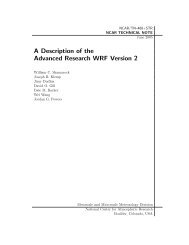You also want an ePaper? Increase the reach of your titles
YUMPU automatically turns print PDFs into web optimized ePapers that Google loves.
<strong>WRF</strong>-VAR<br />
Namelist parameters are used to control the reading of corresponding BUFR files into<br />
<strong>WRF</strong>-Var. For instance, USE_AMSUAOBS, USE_AMSUBOBS, USE_HIRS3OBS,<br />
USE_HIRS4OBS, USE_MHSOBS, USE_AIRSOBS, USE_EOS_AMSUAOBS and<br />
USE_SSMISOBS control whether or not the respective file is read. These are logical<br />
parameters that are assigned to FALSE by default; therefore they must be set to true to<br />
read the respective observation file. Also note that these parameters only control whether<br />
the data is read, not whether the data included in the files is to be assimilated. This is controlled<br />
by other namelist parameters explained in the next section.<br />
NCEP BUFR files downloaded from NCEP’s public ftp server<br />
ftp://ftp.ncep.noaa.gov/pub/data/nccf/com/gfs/prod/gdas.${yyyymmddhh} are Fortranblocked<br />
on big-endian machine and can be directly used on big-endian machines (for example,<br />
IBM). For most Linux clusters with Intel platforms, users need to first unblock the<br />
BUFR files, and then reblock them. The utility for blocking/unblocking is available from<br />
http://www.nco.ncep.noaa.gov/sib/decoders/BUFRLIB/toc/cwordsh<br />
c. Radiative Transfer Model<br />
The core component for direct radiance assimilation is to incorporate a radiative transfer<br />
model (RTM, should be accurate enough yet fast) into the <strong>WRF</strong>-Var system as one part<br />
of observation operators. Two widely used RTMs in NWP community, RTTOV8 * (developed<br />
by EUMETSAT in Europe), and CRTM (developed by the Joint Center for Satellite<br />
Data Assimilation (JCSDA) in US), are already implemented in <strong>WRF</strong>-Var system<br />
with a flexible and consistent user interface. Selecting which RTM to be used is controlled<br />
by a simple namelist parameter RTM_OPTION (1 for RTTOV, the default, and 2<br />
for CRTM). <strong>WRF</strong>-Var is designed to be able to compile with only one of two RTM libraries<br />
or without RTM libraries (for those not interested in radiance assimilation) by the<br />
definition of environment variables “CRTM” and “RTTOV” (see Installing <strong>WRF</strong>-Var<br />
section).<br />
Both RTMs can calculate radiances for almost all available instruments aboard various<br />
satellite platforms in orbit. An important feature of <strong>WRF</strong>-Var design is that all data structures<br />
related to radiance assimilation are dynamically allocated during running time according<br />
to simple namelist setup. The instruments to be assimilated are controlled at run<br />
time by four integer namelist parameters: RTMINIT_NSENSOR (the total number of sensors<br />
to be assimilated), RTMINIT_PLATFORM (the platforms IDs array to be assimilated<br />
with dimension RTMINIT_NSENSOR, e.g., 1 for NOAA, 9 for EOS, 10 for METOP and<br />
2 for DMSP), RTMINIT_SATID (satellite IDs array) and RTMINIT_SENSOR (sensor<br />
IDs array, e.g., 0 for HIRS, 3 for AMSU-A, 4 for AMSU-B, 15 for MHS, 10 for SSMIS,<br />
11 for AIRS). For instance, the configuration for assimilating 12 sensors from 7 satellites<br />
(what <strong>WRF</strong>-Var can assimilated currently) will be<br />
*<br />
Current release is RTTOV9, while there is no plan to incorporate RTTOV9 into <strong>WRF</strong>-<br />
Var.<br />
<strong>WRF</strong>-<strong>ARW</strong> V3: User’s <strong>Guide</strong> 6-22

















